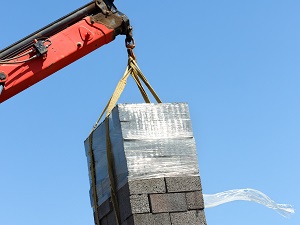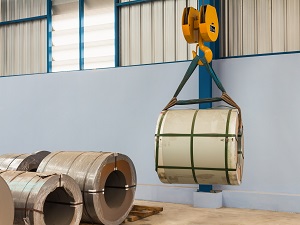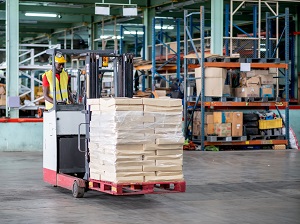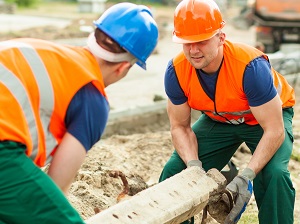Workers must be aware of both manual handling safety concerns and safe equipment operating techniques on the job.

Handling materials can involve diverse operations such as hoisting tons of steel with a crane, driving a truck loaded with concrete blocks, carrying bags or materials manually, and stacking palletized bricks or other materials such as drums, barrels, kegs, and lumber.
Material handling operations provide a continuous flow of parts and assemblies through the work site and ensure that materials are available when needed. Unfortunately, the improper handling of materials often result in costly injuries.
Material Handling Hazards
Whether moving materials manually or mechanically, workers must know and understand the potential hazards associated material handling and the controls to implement to minimize the danger.
Some of the common hazards associated with material handling include:
- Falling materials and collapsing loads that can crush or pin workers
- Back injuries due to improper lifting techniques
- Struck-by material or equipment hazards
- Caught-in or pinch point material handling injuries
- Damage to racking systems and inventory
- Injuries due to incorrectly cutting ties or securing devices

Material Handling Safety Precautions
Use caution when manually handling material. If lifting is required to move a load, remember to bend at the knees, not at the waist. Stack heavier goods and materials that will be handled manually on the bottom or mid-level shelves to reduce strain on the back.
To prevent injury from attempting to lift oversize loads, seek help when loads are so bulky that it cannot be grasped properly, when you can’t see around or over a load when carrying it, or anytime you can’t handle a load safely by yourself.
When placing blocks under a raised load, be careful to ensure that the load is not released before removing your hands from under the load.
Beware of laceration and puncture hazards when packing or unpacking crates or boxes. Watch for protrusions such as nails, screws, staples, splintering wood, broken boards, and metal banding or straps. Removing any sharp object that could cause injury is a priority when unpacking any crate.
When cutting shrink wrap, boxes or other material, direct the blade away from your face and body. Do not use any cutting device near your eyes/face and ensure co-workers are a safe distance from the area where blades of any kind are being used.

Pallets
Wood pallets are the most common type of pallet used but they can be also be made of plastic or metal. When working with pallets, injuries can be caused by issues such as:
- Using a damaged pallet
- Selecting the wrong sized pallet for racking
- Handling pallets with a forklift incorrectly
- Exceeding the maximum load for the pallet
Inspect pallets before use, specifically looking for loose or broken boards or stringers or protruding nails. Ensure any pallets in use are not damaged. Know the safe load capacity of the pallets being used. Use pallets that are the correct size. Pallets that are too small for the rack may become a hazard. Stack empty pallets flat, not leaning up on their sides. Always wear gloves when handling pallets.
Pallet jacks are commonly regarded as being safer than a forklift, but there are still safety precautions that all pallet jack operators should follow, including:
- Operate the pallet jack at a safe speed. Start moving slowly and come to a stop slowly.
- Do not steer pallet jacks onto uneven surfaces and avoid steep inclines.
- When descending any ramp, always keep the pallet jack in front of you. Never pull a pallet jack down any incline!

Mechanical Lifting Equipment
Using mechanical equipment, like forklifts, to move and store materials increases the potential for employee injuries. Important! Only trained and authorized workers are allowed to operate forklifts.
All materials handling equipment has rated capacities that determine the maximum weight the equipment can safely handle and the conditions under which it can handle that weight. Do not exceed the maximum load capacity when moving materials with equipment.
Forklift Safety
When moving materials with a forklift:
- Center the load on the forks as close to the mast as possible to minimize the potential for the truck tipping or the load falling.
- Have clear visibility of the work area and ensure you have enough clearance when raising, loading, and operating a forklift.
- Consider the noise level at the worksite. Do not assume other workers are able to hear a back-up alarm.
- Adjust the load to the lowest position when traveling.
- Pile and cross-tier all stacked loads correctly when possible.
- Always wear a seatbelt when operating a forklift.
- Be aware of other vehicles in the work area.
- Use horns at cross aisles and obstructed areas.
- Watch for pedestrians and observe speed limits.
- Keep a safe distance from platform and ramp edges.

When using aisles and passageways to move materials mechanically, workers must allow sufficient clearance for aisles at loading docks, through doorways, wherever turns must be made, and in other parts of the work site.
OSHA General Industry Standard 1910.176(a) Where mechanical handling equipment is used, sufficient safe clearances shall be allowed for aisles, at loading docks, through doorways and wherever turns or passage must be made.
Providing sufficient clearance for mechanically-moved materials will prevent:
- workers from being pinned between the equipment and fixtures, such as walls, racks, posts, stacks of material or other heavy equipment.
- the load from striking an obstruction and falling on a worker.
Aisles and passageways must be kept clear and in good repair to allow for the safe movement of material handling equipment.
When there is a difference in road or working levels, use ramps, blocking or grading to ensure that material handling equipment can move safely between the two levels.
OSHA Construction Standard 1926.250(a)(4) When a difference in road or working levels exist, means such as ramps, blocking, or grading shall be used to ensure the safe movement of vehicles between the two levels.
Personal Protective Equipment
Wear appropriate PPE for all material handling work tasks, which may include:
- Gloves, when unpacking crates and handling materials to protect from lacerations
- Steel-Toed Boots, to protect feet when handling heavy loads that could fall
- Safety Glasses, when cutting banding, strapping or shrink wrap
- Hard Hats, to protect yourself from struck-by or falling object hazards


.jpeg)
